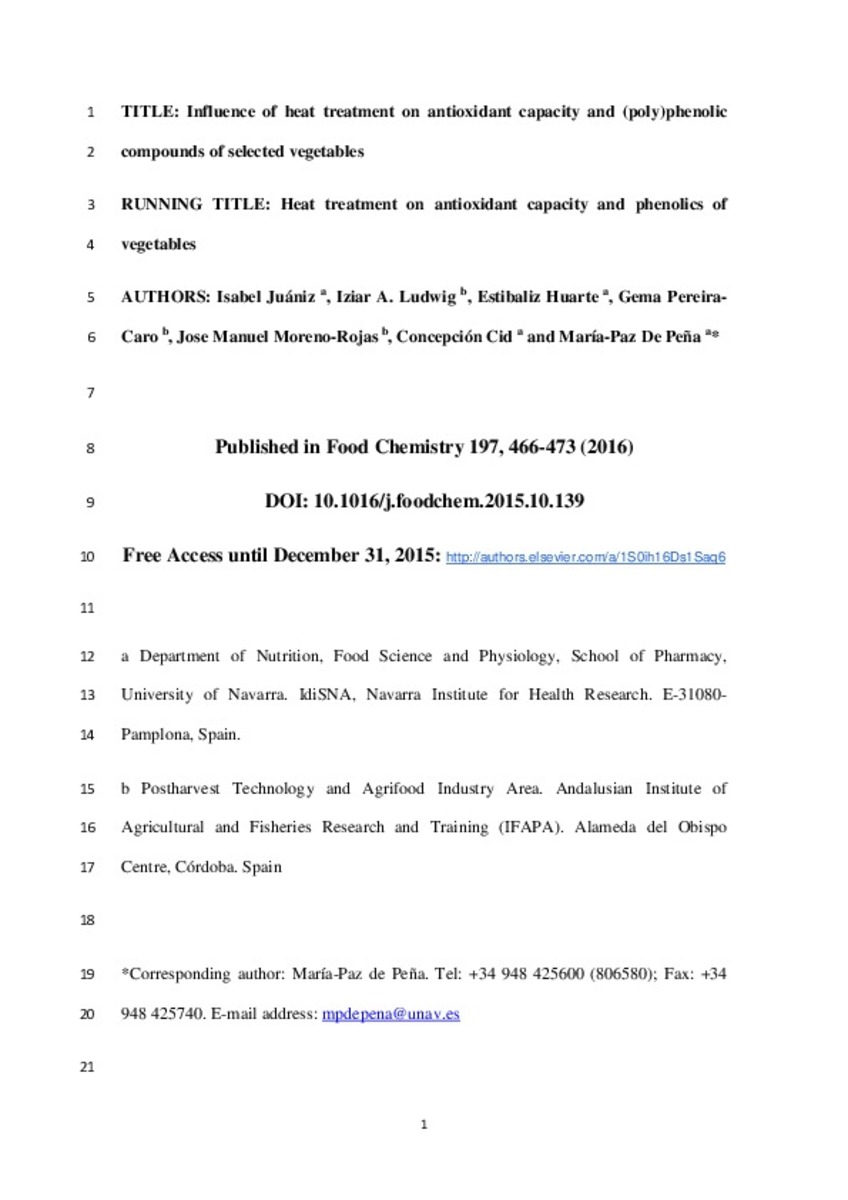Full metadata record
| DC Field | Value | Language |
|---|---|---|
| dc.creator | Juaniz, I. (Isabel) | - |
| dc.creator | Ludwig, I.A. (Iziar Amaia) | - |
| dc.creator | Huarte, E. (Estibaliz) | - |
| dc.creator | Pereira-Caro, G. (Gema) | - |
| dc.creator | Moreno-Rojas, J. M. (José Manuel) | - |
| dc.creator | Cid, C. (Concepción) | - |
| dc.creator | Peña, M.P. (María Paz) de | - |
| dc.date.accessioned | 2016-03-01T13:23:31Z | - |
| dc.date.available | 2016-03-01T13:23:31Z | - |
| dc.date.issued | 2016 | - |
| dc.identifier.citation | Juániz I, Ludwig IA, Huarte E, Pereira-Caro G, Moreno-Rojas JM, Cid C, et al. Influence of heat treatment on antioxidant capacity and (poly)phenolic compounds of selected vegetables. Food Chem 2016;197(Pt A):466-473 | es_ES |
| dc.identifier.issn | 0308-8146 | - |
| dc.identifier.uri | https://hdl.handle.net/10171/40095 | - |
| dc.description.abstract | The impact of cooking heat treatments (frying in olive oil, frying in sunflower oil and griddled) on the antioxidant capacity and (poly)phenolic compounds of onion, green pepper and cardoon, was evaluated. The main compounds were quercetin and isorhamnetin derivates in onion, quercetin and luteolin derivates in green pepper samples, and chlorogenic acids in cardoon. All heat treatments tended to increase the concentration of phenolic compounds in vegetables suggesting a thermal destruction of cell walls and sub cellular compartments during the cooking process that favor the release of these compounds. This increase, specially that observed for chlorogenic acids, was significantly correlated with an increase in the antioxidant capacity measured by DPPH (r=0.70). Griddled vegetables, because of the higher temperature applied during treatment in comparison with frying processes, showed the highest amounts of phenolic compounds with increments of 57.35%, 25.55% and 203.06% compared to raw onion, pepper and cardoon, respectively. | es_ES |
| dc.description.sponsorship | Spanish Ministry of Economy and Competitiveness (AGL2014-52636-P) and PIUNA (Plan de Investigación de la Universidad de Navarra). GP-C is supported by a postdoctoral research contract funded by the Andalusian Institute of Agricultural and Fisheries Research and Training (IFAPA) and the European Social Funds (ESF). | es_ES |
| dc.language.iso | eng | es_ES |
| dc.publisher | Elsevier | es_ES |
| dc.relation | the European Social Funds (ESF). | - |
| dc.relation | PIUNA (Plan de Investigación de la Universidad de Navarra). | - |
| dc.relation | Spanish Ministry of Economy and Competitiveness (AGL2014-52636-P) | - |
| dc.relation | Andalusian Institute of Agricultural and Fisheries Research and Training (IFAPA) | - |
| dc.rights | info:eu-repo/semantics/openAccess | * |
| dc.subject | Phenolics | es_ES |
| dc.subject | Flavonoids | es_ES |
| dc.subject | Chlorogenic acids | es_ES |
| dc.subject | Antioxidants | es_ES |
| dc.subject | Vegetables | es_ES |
| dc.subject | Heat treatment | es_ES |
| dc.subject | Materias Investigacion::Ciencias de la Salud::Nutrición y dietética | es_ES |
| dc.title | Influence of heat treatment on antioxidant capacity and (poly)phenolic compounds of selected vegetables | es_ES |
| dc.title.alternative | Heat treatment on antioxidant capacity and phenolics of vegetables | es_ES |
| dc.type | info:eu-repo/semantics/article | es_ES |
| dc.identifier.doi | http://dx.doi.org/10.1016/j.foodchem.2015.10.139 | es_ES |
Files in This Item:
Statistics and impact
Items in Dadun are protected by copyright, with all rights reserved, unless otherwise indicated.






